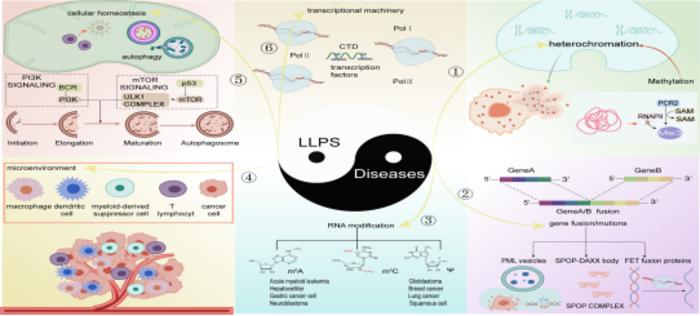This paper, led by Professor Wu (Wenzhou Institute University, Wenzhou Medical University) and Professor Huang (Northeastern University), explores LLPS, a phenomenon closely associated with various diseases, including cancer and neurodegenerative disorders. As a frontier research area, LLPS plays a significant role in cancer through its regulation of multiple facets, including signaling pathways, gene expression, and tumor microenvironment. Dysregulation of LLPS leads to the formation of various aggregates, such as amyloid proteins, suggesting that modulating LLPS in pathogenic proteins could present a promising direction for treating neurodegenerative diseases and cancer.

Credit: from MedComm (DOI: 10.1002/mco2.640)
This paper, led by Professor Wu (Wenzhou Institute University, Wenzhou Medical University) and Professor Huang (Northeastern University), explores LLPS, a phenomenon closely associated with various diseases, including cancer and neurodegenerative disorders. As a frontier research area, LLPS plays a significant role in cancer through its regulation of multiple facets, including signaling pathways, gene expression, and tumor microenvironment. Dysregulation of LLPS leads to the formation of various aggregates, such as amyloid proteins, suggesting that modulating LLPS in pathogenic proteins could present a promising direction for treating neurodegenerative diseases and cancer.
LLPS refers to the spontaneous formation of highly concentrated, segregated liquid-phase regions within cells through interactions between specific biomacromolecules (e.g., proteins and RNA). A notable characteristic of this mechanism is the formation of membraneless organelles, which achieve functional compartmentalization and local concentration without membrane structures. RNA-RNA and RNA-protein interactions play critical roles in LLPS, with scaffolding proteins supporting protein-RNA interaction networks to form condensates involved in various diseases through multivalent interactions and external factors.
The authors unveil the enigmatic role of LLPS in various signaling pathways, including cGAS–STING, Wnt/β-Catenin, and RAS/MAPK, by discussing its role in immune cell maturation and activation, immune signal transduction, and immunomodulation. The paper also introduces RNA modifications, which have emerged as crucial regulatory factors for transcript expression, molecular function, and homeostasis. These modifications participate in diverse signaling pathways, with multiple proteins regulating disease progression. The article enumerates the roles and manifestations of LLPS in various modifications, including m6A and m7G.
In conclusion, this comprehensive review provides a detailed summary of LLPS complexity in constructing signaling pathways, emphasizing its role in neurodegenerative diseases and cancer. It explores how RNA modifications influence LLPS to alter disease progression and discusses the possibility of manipulating LLPS processes to restore cellular homeostasis or develop therapeutic drugs. By elucidating the connections between LLPS, RNA modifications, and their roles in diseases, this review aims to highlight potential therapeutic opportunities in this emerging field.
Journal
MedComm
DOI
Method of Research
Literature review
Subject of Research
Not applicable
Article Title
Liquid–liquid phase separation in diseases
Article Publication Date
13-Jul-2024
COI Statement
The authors declare that they have no conflict of interest.



